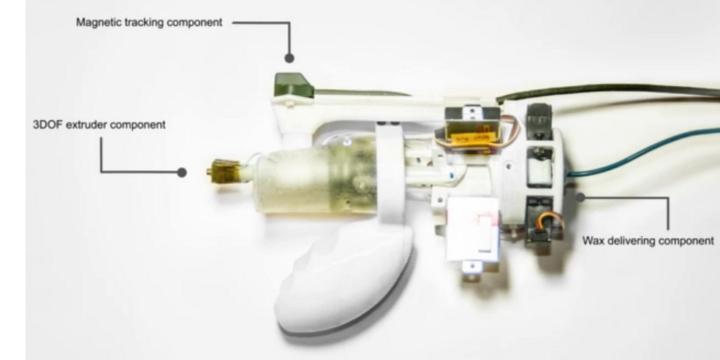Results 1 to 4 of 4
Thread: D-Coil Wax 3D Printing Pen
-
04-27-2015, 09:03 AM #1
D-Coil Wax 3D Printing Pen
A team of researchers from Cornell University Information Science and the Hebrew University of Jerusalem have built a tool and digital modeling approach which uses wax coiling to rethink the design and execution of 3D prints. They call it D-Coil, and it lets users can define a shape to extrude, and then using a hand-held and actuated extruder which guides the motion of the hand and arm, extrude wax while it simultaneously creates a 3D printable digital model in Rhino software. It's an intuitive and non-technical method of 3D modeling which removes the necessity of CAD skills from the equation, and the paper the team wrote on the subject, D-Coil: A Hands-on Approach to Digital 3D Models Design, describes their method of building a system which simplifies the use of CAD systems without having “mastery of complex construction commands.” You can read the whole story here: http://3dprint.com/60922/d-coil-3d-wax-printing-pen/
Below is a photo of the D-Coil system:

-
04-27-2015, 02:44 PM #2Staff Engineer

- Join Date
- Jan 2014
- Location
- Oakland, CA
- Posts
- 935
I might be missing something, but this looks like a combination of the 3doodler (or the older Matt Wax Pen) with a very imprecise method of signalling someone where a line is supposed to be. This is something that a conventional 3d printer does pretty well, and (from looking at the results) that this thing does poorly. If the device needs contour lines produced in Rhino to follow, I don't see how it obviates the need for CAD modeling. It just seems like a way to introduce human error into the process.
Andrew Werby
www.computersculpture.com
-
04-28-2015, 03:04 AM #3Student

- Join Date
- Apr 2015
- Posts
- 3
Granted, the output demonstrated is rather unsophisticated, but I don't think that is the point. This device is applying the same technology used in haptic input devices, to out-put devices. It may address the problem of lack of 'immediate material response', a tacit skill of an artisan that does not translate well to producing 3D printed sculpture/art. It is far from perfect, but the concept is very interesting.
On a more 'worthy' note - this technology has great potential as a therapeutic device for Parkinson's sufferers or anyone with motor function disabilities.
-
04-28-2015, 05:23 AM #4
It's interesting and I'm sure must have a practical usage.
Just can't really see one myself.






 Reply With Quote
Reply With Quote




Extruder not feeding during print,...
04-24-2024, 01:59 AM in Tips, Tricks and Tech Help